Create a free profile to get unlimited access to exclusive videos, sweepstakes, and more!
Yesterday's stunning aurora could happen again as geomagnetic storms increase
Every electromagnetic cloud has an aurora lining.

Throughout history, aurora (often referred to as the Northern Light, in the Northern Hemisphere) have been a source of wonder, and for good reason. They are, from a certain point of view, the luminous afterglow of cosmic warfare between our planet and the Sun. And in the 2006 disaster flick Solar Attack (streaming now on Peacock!) that warfare makes its way to our home turf.
RELATED: The Earth just got hit with two powerful solar flares and more are on the way
The fictional Solar and Near Earth Laboratory (SNEL) launches a probe to study methane concentrations in Earth’s atmosphere. It confirms that methane now comprises roughly five percent of the atmosphere — up from its usual paltry 0.00017% — right before it is destroyed by a powerful coronal mass ejection (CME). The probe isn’t the only casualty. The CME also destroys a crewed orbital spacecraft, a sizeable chunk of Earth’s satellites, and the nation of New Zealand. Worst of all, it ignites all of that atmospheric methane, threatening to snuff out all life on Earth unless we hit the North Pole with nuclear missiles. You just have to watch it.
Fortunately for those of us in the real world, a CME won’t explode the atmosphere, but they can and do create stunning visual displays in the night sky. If you happen to live somewhere in the northern hemisphere, you might have had a front row seat to one of those displays on April 23, 2023. Earlier in the day, the Space Weather Prediction Center issued a Moderate (level 2 out of 5 on NOAA’s space weather scale) Geomagnetic Storm Watch with the possibility of developing into a Strong (level 3) storm later in the night.
The watch was the result of a coronal mass ejection which occurred on April 21, riding on the coattails of a dual solar flare just two days earlier. On an ordinary day, electrified gas from the Sun travels down Earth’s electromagnetic field lines and into the atmosphere at the poles. Interactions with oxygen and nitrogen create shifting ribbons of brilliantly colored light visible in places like Canada, Alaska, and Scandinavia. April 23, however, was not an ordinary day.
Having traveled through space at a blistering two million miles per hour, a wave of ejected plasma struck Earth’s electromagnetic field, generating a geomagnetic storm. By the time it arrived, it had been upgraded not once but twice to Severe (level 4). Unusually high levels of energy in the atmosphere pushed the aurora much farther toward the equator than is typical. As a result, nature’s most beautiful light show, usually reserved for the brave few living at higher latitudes, made a surprise appearance in as many as 30 states in the U.S. as well as parts of Scotland and norther Europe.
While these events aren’t incredibly common, they do happen roughly 100 times during each of the Sun’s 11-year cycles. And they’re likely to be more common as we approach the upcoming solar maximum in the summer of 2025. So, if you missed last night’s light show, keep an eye on the space weather forecast. You could have another chance any day (night) now.
Solar Attack is streaming on Peacock!


























